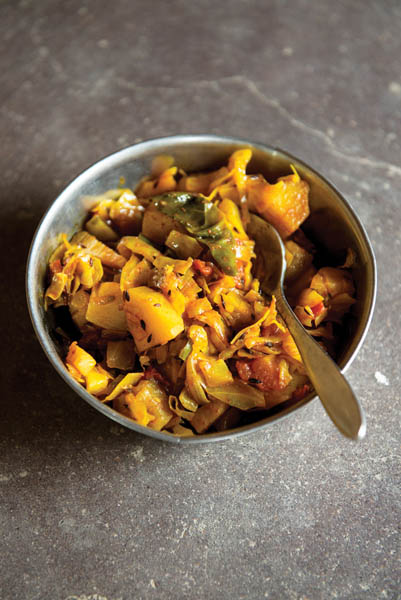 Bund Gobhi Aur Aloo Ki Subzi (Spicy Cabbage & Potato Curry)
Bund Gobhi Aur Aloo Ki Subzi (Spicy Cabbage & Potato Curry)
This vibrant Indian curry comes from the Meghwal tribe of Gujarat, India. Since there is little local agriculture—the closest vegetable market is in the capital city of Bhuj, 35 miles away—the cuisine is spare, but it is delicious in its simplicity. This cabbage-and-potato curry is traditionally cooked over a wood fire, along with millet rotla, a flatbread, but the stovetop works just as well.
From: Saveur SERVES 4
3 tbsp. canola oil
1½ tsp. cumin seeds
½ tsp. red chile powder, such as cayenne
½ tsp. ground turmeric
3 small green Thai chiles or 1 serrano, sliced ½" thick
2 Indian or regular bay leaves
1 small red onion, quartered and cut into ¼" wedges
1½ lb. Yukon Gold potatoes, peeled, quartered, and sliced ¼" thick
4 plum tomatoes, chopped
½ small head green cabbage, cored and cut into 1" pieces
Kosher salt, to taste
Heat oil in a 12" skillet over medium-high. Cook cumin seeds until they pop, 1–2 minutes. Add chile powder, turmeric, chiles, bay leaves, and onion; cook until onion is soft, 3–4 minutes. Stir in potatoes, tomatoes, cabbage, and salt; cook, covered, until potatoes are tender, about 30 minutes.
Bajra Na Rotla / Roti / Traditional Gujarati Pearl Millet Bread
Bajra Na Rotla also known as Bajra Roti is a plain and simple flat bread made from pearl millet flour. Bajra Na Rotla and Ringna No Olo is an all time winter favorite food, especially when the rotla comes straight out of the stove to the plate. The millet flour is rich in proteins, and is also a source of iron, calcium and other minerals like potassium, magnesium and zinc. In many regions of Gujarat, hot rotla’s are also eaten with fresh butter and jaggery and often given to children as a snack. From http://www.archanaskitchen.com Makes 6 rotla’s
1 cup millet flour
salt to taste
In a bowl combine the flour and salt; add water a little at a time to make stiff dough. Cover the dough and allow it to rest for 10 minutes. Knead once again and divide the dough 6 portions. Preheat your iron skillet on medium heat.
Traditionally this rolta is cooked on a clay skillet, if you do have one, go ahead and use it. But for all practical purposes the iron skillet works just as well.
Using wet palms place the ball on flat surface and flatten the ball with your palms. Continue pressing the dough until the rotla has attained a round shape. If you find any cracks, use your finger to pinch the cracks together and seal them. Toss the dough on flour if it gets sticky.
Place the rotla on the heated iron skillet and cook for a few seconds on one side and turn over gently with a flat spatula to the other side.
Turn the heat to low and allow the rotla to cook slowly. Once again flip and cook on low heat until well done. You will notice that it begins to puff when it is cooking slowly on low heat. There are times the rotla will not puff; so don’t get hassled, just allow it to cook evenly and you can still savor it. Continue the process with the remaining portions of the dough. Turn off the heat.
Serve immediately, if it cools down it will taste very dry and bland.


